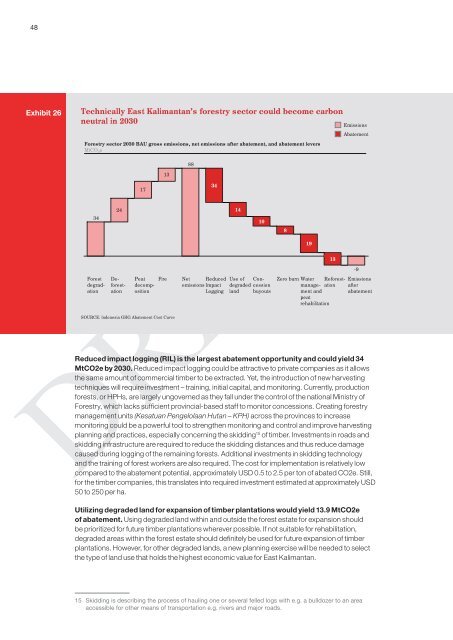East Kalimantan Environmentally Sustainable Development Strategy
East Kalimantan Environmentally Sustainable Development Strategy
East Kalimantan Environmentally Sustainable Development Strategy
You also want an ePaper? Increase the reach of your titles
YUMPU automatically turns print PDFs into web optimized ePapers that Google loves.
48<br />
Exhibit 26<br />
Technically <strong>East</strong> <strong>Kalimantan</strong>’s forestry sector could become carbon<br />
neutral in 2030<br />
Forestry sector 2030 BAU gross emissions, net emissions after abatement, and abatement levers<br />
MtCO 2 e<br />
34<br />
Forest<br />
degradation<br />
24<br />
Peat<br />
decomposition<br />
Deforestation<br />
17<br />
Net Reduced Use of Concession<br />
emissions Impact degraded<br />
Logging land buyouts<br />
13<br />
Fire<br />
SOURCE: Indonesia GHG Abatement Cost Curve<br />
88<br />
34<br />
14<br />
Emissions<br />
Abatement<br />
Zero burn Water Reforestation<br />
Emissions<br />
management<br />
after<br />
and<br />
abatement<br />
peat<br />
rehabilitation<br />
Reduced impact logging (RIL) is the largest abatement opportunity and could yield 34<br />
MtCO2e by 2030. Reduced impact logging could be attractive to private companies as it allows<br />
the same amount of commercial timber to be extracted. Yet, the introduction of new harvesting<br />
techniques will require investment – training, initial capital, and monitoring. Currently, production<br />
forests, or HPHs, are largely ungoverned as they fall under the control of the national Ministry of<br />
Forestry, which lacks sufficient provincial-based staff to monitor concessions. Creating forestry<br />
management units (Kesatuan Pengelolaan Hutan – KPH) across the provinces to increase<br />
monitoring could be a powerful tool to strengthen monitoring and control and improve harvesting<br />
planning and practices, especially concerning the skidding 15 of timber. Investments in roads and<br />
skidding infrastructure are required to reduce the skidding distances and thus reduce damage<br />
caused during logging of the remaining forests. Additional investments in skidding technology<br />
and the training of forest workers are also required. The cost for implementation is relatively low<br />
compared to the abatement potential, approximately USD 0.5 to 2.5 per ton of abated CO2e. Still,<br />
for the timber companies, this translates into required investment estimated at approximately USD<br />
50 to 250 per ha.<br />
DRAFT<br />
10<br />
8<br />
19<br />
13<br />
-9<br />
Utilizing degraded land for expansion of timber plantations would yield 13.9 MtCO2e<br />
of abatement. Using degraded land within and outside the forest estate for expansion should<br />
be prioritized for future timber plantations wherever possible. If not suitable for rehabilitation,<br />
degraded areas within the forest estate should definitely be used for future expansion of timber<br />
plantations. However, for other degraded lands, a new planning exercise will be needed to select<br />
the type of land use that holds the highest economic value for <strong>East</strong> <strong>Kalimantan</strong>.<br />
15 Skidding is describing the process of hauling one or several felled logs with e.g. a bulldozer to an area<br />
accessible for other means of transportation e.g. rivers and major roads.

















